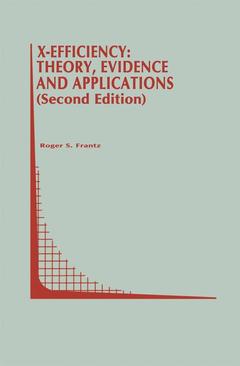Description
X-Efficiency: Theory, Evidence and Applications, Softcover reprint of the original 1st ed. 1997
Topics in Regulatory Economics and Policy Series, Vol. 23
Author: Frantz Roger S.
Language: English
Subject for X-Efficiency: Theory, Evidence and Applications:
Approximative price 105.49 €
In Print (Delivery period: 15 days).
Add to cart
Publication date: 10-2012
167 p. · 15.5x23.5 cm · Paperback
167 p. · 15.5x23.5 cm · Paperback
Description
/li>Contents
/li>
My interest in X-Efficiency (XE) dates back to 1978. At the time, I was writing the dissertation for my Ph. D. at Washington State University. My dissertation was concerned with the role of attitudes in the school-to-work transition among young men. I was advised by Professor Millard Hastay (a member of my committee) to look at Leibenstein's "new" book, Beyond Economic Man. One of the things that caught my attention was his behavioral description of (selective) rationality. It seemed that Leibenstein' s behavioral description of a (selectively) rational individ ual was very similar to what psychologists such as Abraham Maslow were reporting as being the product of a particular motivational system. In other words, I was impressed with the idea that what Leibenstein was referring to as X-inefficiency was being discussed by psychologists as "the way it (often) is. " So from the beginning I always considered the concept ofX-(in)efficiency to be a valuable one for understanding human behavior. I have since come to believe that this is particularly true when considering behavior in non-market environments, i. e. , within the firm. Work on this book, however, can most realistically said to have started with work which I began in 1982 while I was a Visiting Scholar at Harvard University. Professor Leibenstein suggested that I consider how some empirical evidence which was being cited as evidence for the role of property rights might also be consistent with XE theory. (The consistency, in both directions, is considerable.
List of Figures and Tables. Preface. Foreword to First Edition; Harvey Leibenstein. Foreword to Second Edition; Mark Perlman. 1. Introduction. 2. Production, Cost, and Welfare: A Review. 3. X-Efficiency: The Intellectual Setting and an Introduction to the Theory. 4. X-Efficiency Theory: 1. 5. X-Efficiency Theory: 2. 6. Empirical Evidence: Regulated Industries. 7. Empirical Evidence: Market Structure and Firm Organization. 8. Empirical Studies: Input Ratios and International Trade. 9. X-Efficiency, Its Critics, and a Reply. 10. Implications and Conclusions. References. Index.
© 2024 LAVOISIER S.A.S.




